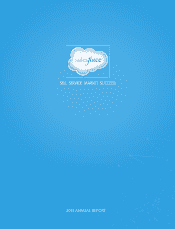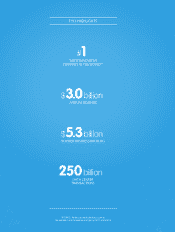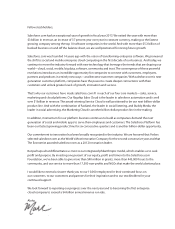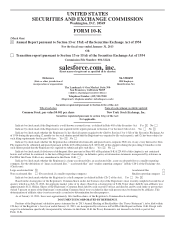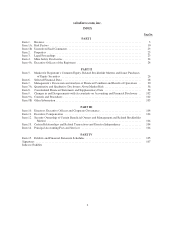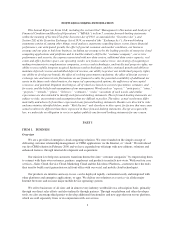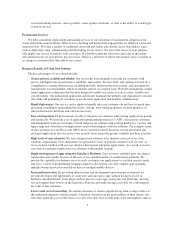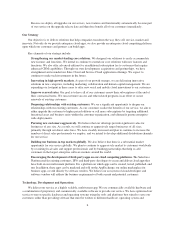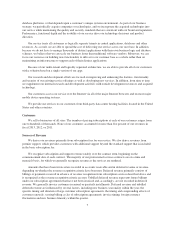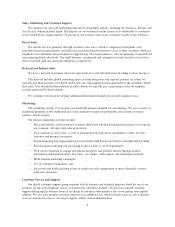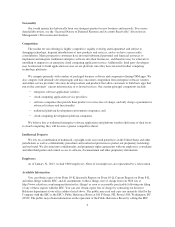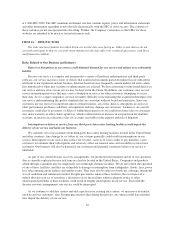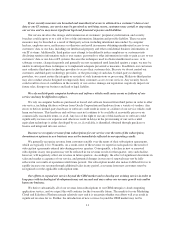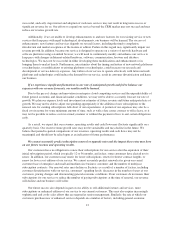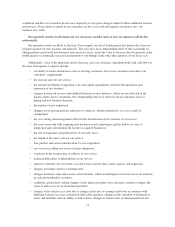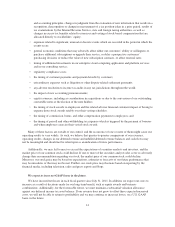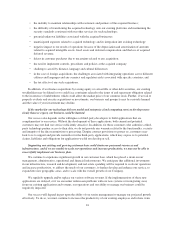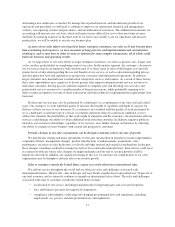Salesforce.com 2013 Annual Report Download - page 11
Download and view the complete annual report
Please find page 11 of the 2013 Salesforce.com annual report below. You can navigate through the pages in the report by either clicking on the pages listed below, or by using the keyword search tool below to find specific information within the annual report.database platforms, or that depends upon a customer’s unique systems environment. As part of our business
strategy, we periodically acquire companies or technologies, and we incorporate the acquired technologies into
our service while maintaining the quality and security standards that are consistent with our brand and reputation.
Performance, functional depth and the usability of our service drive our technology decisions and product
direction.
Our service treats all customers as logically separate tenants in central applications, databases and other
resources. As a result, we are able to spread the cost of delivering our service across our user base. In addition,
because we do not have to manage thousands of distinct applications with their own business logic and database
schemas, we believe that we can scale our business faster than traditional software vendors. Moreover, we can
focus our resources on building new functionality to deliver to our customer base as a whole rather than on
maintaining an infrastructure to support each of their distinct applications.
Because of our multi-tenant and logically separated architecture, we are able to provide all of our customers
with a solution based on a single version of our apps.
Our research and development efforts are focused on improving and enhancing the features, functionality
and security of our existing service offerings as well as developing new services. In addition, from time to time
we supplement our internal research and development activities with outside development resources and acquired
technology.
Our customers access our service over the Internet via all of the major Internet browsers and on most major
mobile device operating systems.
We provide our services to our customers from third-party data center hosting facilities located in the United
States and other countries.
Customers
We sell to businesses of all sizes. The number of paying subscriptions at each of our customers ranges from
one to hundreds of thousands. None of our customers accounted for more than five percent of our revenues in
fiscal 2013, 2012, or 2011.
Sources of Revenue
We derive our revenues primarily from subscription fees for our service. We also derive revenues from
premier support, which provides customers with additional support beyond the standard support that is included
in the basic subscription fee.
We recognize subscription and support revenue ratably over the contract term, beginning on the
commencement date of each contract. The majority of our professional services contracts are on a time and
materials basis, for which we generally recognize revenue as the services are rendered.
Amounts that have been invoiced are recorded in accounts receivable and in deferred revenue or revenue,
depending on whether the revenue recognition criteria have been met. Deferred revenue primarily consists of
billings or payments received in advance of revenue recognition from subscription services described above and
is recognized as the revenue recognition criteria are met. Unbilled deferred revenue represents future billings
under our subscription agreements that have not been invoiced and, accordingly, are not recorded in deferred
revenue. We generally invoice customers in annual or quarterly installments. Deferred revenue and unbilled
deferred revenue are influenced by several factors, including new business seasonality within the year, the
specific timing and duration of large customer subscription agreements, the timing and compounding effects of
customer renewals, varying billing cycles of subscription agreements, invoice timing, foreign currency
fluctuations and new business linearity within the quarter.
7

